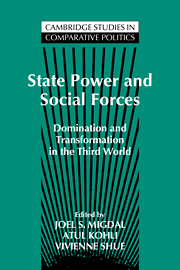Book contents
- Frontmatter
- Contents
- Preface
- List of contributors
- State Power and Social Forces
- Introduction: developing a state-in-society perspective
- PART I THEORETICAL AND METHODOLOGICAL CONSIDERATIONS
- PART II STATES: EMBEDDED IN SOCIETY
- PART III SOCIAL FORCES: ENGAGED WITH STATE POWER
- 6 Labor divided: sources of state formation in modern China
- 7 Business conflict, collaboration, and privilege in interwar Egypt
- 8 A time and a place for the nonstate: social change in the Ottoman Empire during the “long nineteenth century”
- 9 Peasant–state relations in postcolonial Africa: patterns of engagement and disengagement
- 10 Engaging the state: associational life in sub-Saharan Africa
- PART IV CONCLUSION
- Index
7 - Business conflict, collaboration, and privilege in interwar Egypt
Published online by Cambridge University Press: 05 June 2012
- Frontmatter
- Contents
- Preface
- List of contributors
- State Power and Social Forces
- Introduction: developing a state-in-society perspective
- PART I THEORETICAL AND METHODOLOGICAL CONSIDERATIONS
- PART II STATES: EMBEDDED IN SOCIETY
- PART III SOCIAL FORCES: ENGAGED WITH STATE POWER
- 6 Labor divided: sources of state formation in modern China
- 7 Business conflict, collaboration, and privilege in interwar Egypt
- 8 A time and a place for the nonstate: social change in the Ottoman Empire during the “long nineteenth century”
- 9 Peasant–state relations in postcolonial Africa: patterns of engagement and disengagement
- 10 Engaging the state: associational life in sub-Saharan Africa
- PART IV CONCLUSION
- Index
Summary
Elizabeth Perry begins her chapter in this volume – “Labor Divided: Sources of State Formation in Modern China” – with an insightful summary of recent trends in the historiography of working classes. She argues that in reaction to the “unfulfilled promises of Marxism,” recent generations of labor studies “have been obsessed with ‘why not’ questions: Why did workers not develop a class identity? Why did workers … not flock to radical political parties? Why did working-class parties … not engineer Marxist revolutions?” Perry is understandably ambivalent about this “search for sources of weakness in the working class.” The search has led to a deeper appreciation of the diverse and often conflicting forces that comprise any proletariat. She questions, however, why such “intraclass divisions” are understood and analyzed solely as “obstacles” to political organization and action, a logic that is rooted in the belief in a particular trajectory or class project for labor (“the ‘true’ mission of the proletariat”).
In similar fashion, since World War I analysts have wrestled with the unfulfilled promises of liberalism. Theorists in various colonial and dependent territories asked one “why not” question in particular: Why did the indigenous middle class not engineer bourgeois revolutions? For instance, M. Roy and other delegates to the Third International answered this question by combining imperialism theory and nationalism in a formulation that continues to guide thinking on this subject.
- Type
- Chapter
- Information
- State Power and Social ForcesDomination and Transformation in the Third World, pp. 174 - 206Publisher: Cambridge University PressPrint publication year: 1994
- 2
- Cited by

